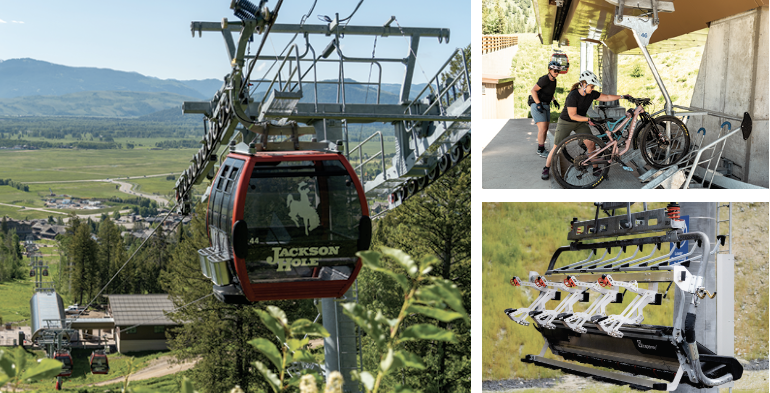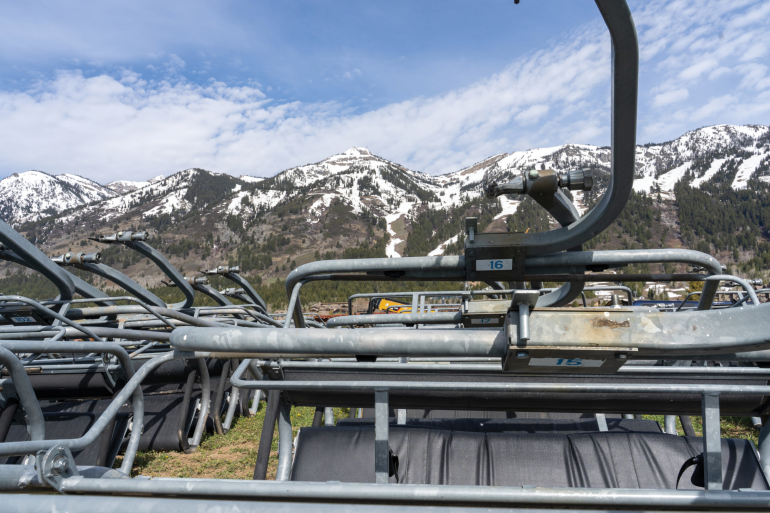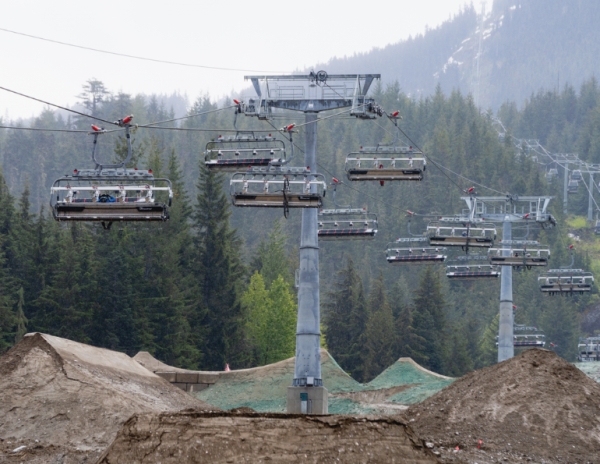For many resorts, adding spring, summer, or fall operations means running lifts thousands of additional hours per year. A Memorial Day to October sightseeing operation can be longer than ski season, adding wear to lifts and reducing maintenance windows. This requires modifications to maintenance schedules and even impacts the design of new lifts.
LIFT MODIFICATIONS
Most lifts designed for skiing cannot simply be turned on in the summer and be safe for sightseeing or mountain biking. Many chairlifts are designed for minimal downloading (perhaps for maintenance only) or a fraction of their winter uphill capacity. Sheave assemblies are often smaller on the downhill side, designed only for passing empty carriers—not the additional weight of passengers. Modifying even a small lift with new sheave assemblies and/or a different motor can cost hundreds of thousands of dollars and require significant engineering and lead time.
Bikes and more. Bike usage generally requires carriers to be modified or added. Some resorts choose bike trays or hook systems, while others acquire entire sets of additional carriers for summer operations. Whitefish Mountain Resort, Mont., and Lake Louise, Alberta, run summer-specific gondola cabins on detachable chairlifts, then store the cabins offline in winter.
There are other aspects of lift ops to address, too. Loading and unloading areas must be modified for summer ops, signage changed, and a season-specific evacuation plan practiced. The cost of these modifications must be analyzed and weighed against potential revenue before committing to additional operations beyond the winter season.
On the plus side, a summer operation typically does not require full capacity, and often half the carriers can simply be removed from service, reducing grip cycles and wear.
MAITENANCE IMPLICATIONS
A major implication of adding operational weeks in summer is that this pushes planned maintenance into tighter downtime windows. That’s not a big issue for all projects; James Marrott, gondola maintenance manager at Jackson Hole Mountain Resort in Wyoming, notes that some tasks, such as tower line work, can be performed mid-summer in short chunks of time.
But other projects, such as a gearbox rebuild, can take weeks. Traditionally, such a project would commence in the summer when daylight is plentiful and weather is best. For a lift operating daily all winter and summer, a big-ticket project might instead be scheduled in October or April, when weather can be worse and daylight is limited.
“Weather is a huge factor for us every spring and fall,” says Marrott. “You have to prioritize where on the mountain you are going to be, and safety becomes a factor.” The later in the offseason a project starts, the more likely unforeseen delays could impact the following season.
Planning is key. Sprawling Whistler Blackcomb, B.C., runs an “always on” schedule where winter sports, mountain biking, sightseeing, and special event operations overlap throughout the year. Director of lift maintenance Scott Patterson notes that there’s a balance between the needs of the business and required maintenance.
“Planned and predicted maintenance schedules are shared with the mountain ops planning team, and we work together to build an operating plan that supports resort needs and scheduled maintenance,” he says.
Selective closings. Whistler Blackcomb is fortunate to have two mountains, one of which typically closes earlier in spring while the other continues operating. This is primarily due to business levels, but it also helps with maintenance and construction scheduling. For the past three years, either Whistler or Blackcomb continued winter operations later into the spring while lift replacement projects got underway earlier on the other mountain. Smaller resorts that don’t have the luxury of two mountains can close one section of the hill to begin maintenance and ensure an on-time start of the next season.
Making time for both summer ops and maintenance requires careful thought. There’s always a need to find a balance between one more day of ticket sales or another wedding and one more day of maintenance time. “We’re up against the wall a lot of the offseason, but everyone [at Jackson Hole] knows we need time for maintenance, and we get it done,” says Marrott.

Managing the unexpected. Of course, despite meticulous planning, sometimes machines break mid-season, causing unplanned closures. When those machines run more of the year, impacts can be magnified.
Sometimes a problem can be temporarily addressed until a more permanent repair can be made. Marrott gives the example of an electric motor failure a few years ago in the middle of summer bike season. “We had to schedule the least bad day to close, with everybody involved to get that motor pulled and then again to get it back in,” he says.
In that case, the lift had multiple diesel backup systems, particularly important on lifts that run intensive hours.
Nondestructive testing. Another aspect of managing a year-round operation is the scheduling of nondestructive testing (NDT). At Jackson Hole, two gondolas that operate year-round have a completely different NDT cycle than winter-only chairlifts, despite code requirements being identical.
On the gondolas, staff remove one or two carriers at a time, with NDT being performed throughout the year by in-house mechanics. Because of the amount of run time, gondola parts are tested every third year, above and beyond the ANSI-required 20 percent per year. On chairlifts that run only in winter, carriers requiring NDT are removed at the end of the season, with parts being tested in large batches by an outside firm at the standard 20 percent interval.
Does multi-season use impact the overall lifespan of a lift? Patterson at Whistler Blackcomb says, “Lift lifespan is impacted by utilization and environment, and the success of our maintenance program is measured by our ability to address both.”
Marrott at Jackson Hole thinks that while cyclic fatigue and wear are a factor, there are also benefits to running lifts more of the year. “I’m of the opinion that lifts don’t like to sit,” he notes. “The longest the Bridger Gondola now sits is a week. It used to sit idle for many weeks, and would not like to restart.”
BUDGET AND STAFFING CONSIDERATIONS
While the impact of utilization on overall lifespan isn’t totally clear, according to the people we spoke to, it is clear that more utilization requires more resources.
“Increased operational hours and equipment cycles accelerates the cadence of maintenance and tightens windows,” notes Patterson.
It also requires more parts. Shorter maintenance windows allow less time to disassemble and reassemble parts and equipment. Parts need to be on site during the maintenance windows, and that means having a larger stock on hand. Mechanics don’t want to be waiting on parts sitting in a truck somewhere when they hit their carefully scheduled maintenance window.
Staffing is another resource that must be bolstered for multi-season operations. “Less time [to do maintenance] requires strategic labor allocation,” says Patterson.
At Jackson Hole, Marrott notes that just converting one gondola to one-third bike carriers takes a maintenance crew an entire week. “You need a robust staff if you are going to have a nearly year-round operation just to keep up with preventative maintenance and extra tasks,” he says.
 At Jackson Hole, nondestructive testing (NDT) is performed throughout the year on gondola carriers, while chairlift carriers that run only in winter are removed at the end of the season (below) and tested in batches. Photo credit: John Bowers.
At Jackson Hole, nondestructive testing (NDT) is performed throughout the year on gondola carriers, while chairlift carriers that run only in winter are removed at the end of the season (below) and tested in batches. Photo credit: John Bowers.
Night shifts. During the operating season, mechanics also must be on standby to address problems and make any needed repairs. Sometimes that means repairing a lift in the dark. To manage the workload, Whistler Blackcomb runs both mechanical and electrical night shifts from 2 p.m. to midnight seven days a week.
“As long as we have lifts operational, we have a night shift,” says Patterson, noting that this year lifts will operate somewhere on Whistler or Blackcomb mountains for 48 straight weeks. The only non-operational time will be a few weeks in late fall before the cycle begins anew.
A plus: staff retention. While maintenance staff typically work year-round regardless of operating schedule, multi-season operations allow staff in other departments opportunities to do the same. At Jackson Hole, operators who work both winter and summer seasons become eligible for enhanced benefits such as paid time off, sick time, 401(k) retirement accounts and health insurance during their second season. The flip side of granting vacation time means managers must account for allowing staff to take those vacations.
Final words of advice. What advice would Patterson and Marrott give to winter-only resorts considering getting into other seasons?
“Make sure you have sufficient planning, budget, skilled labor, and inventory to support year-round operations,” says Patterson.
“You have to get a plan in place with all players at the table before diving in [to multi-season operation],” says Marrott. “Communication is paramount to a successful year-round operation.”






